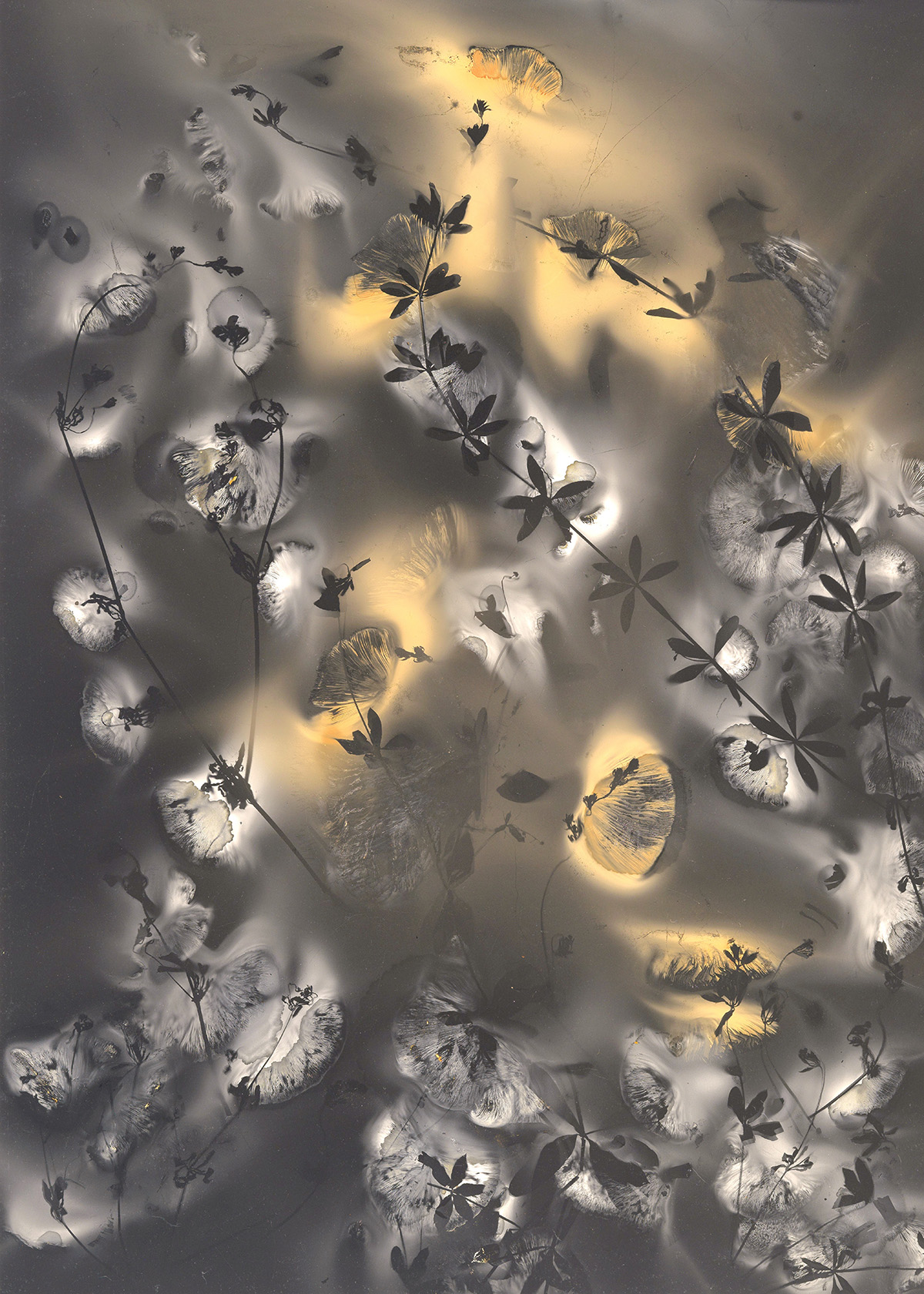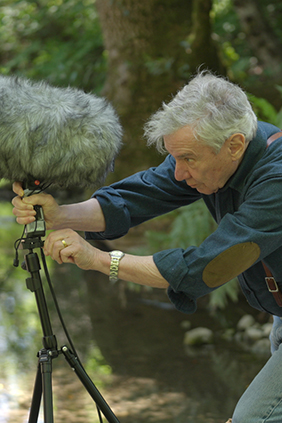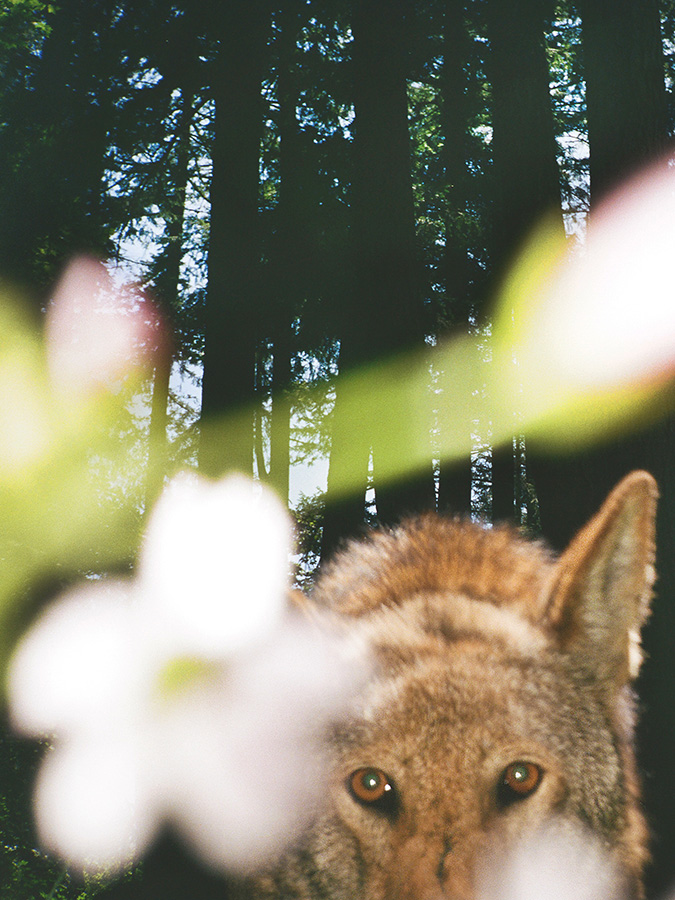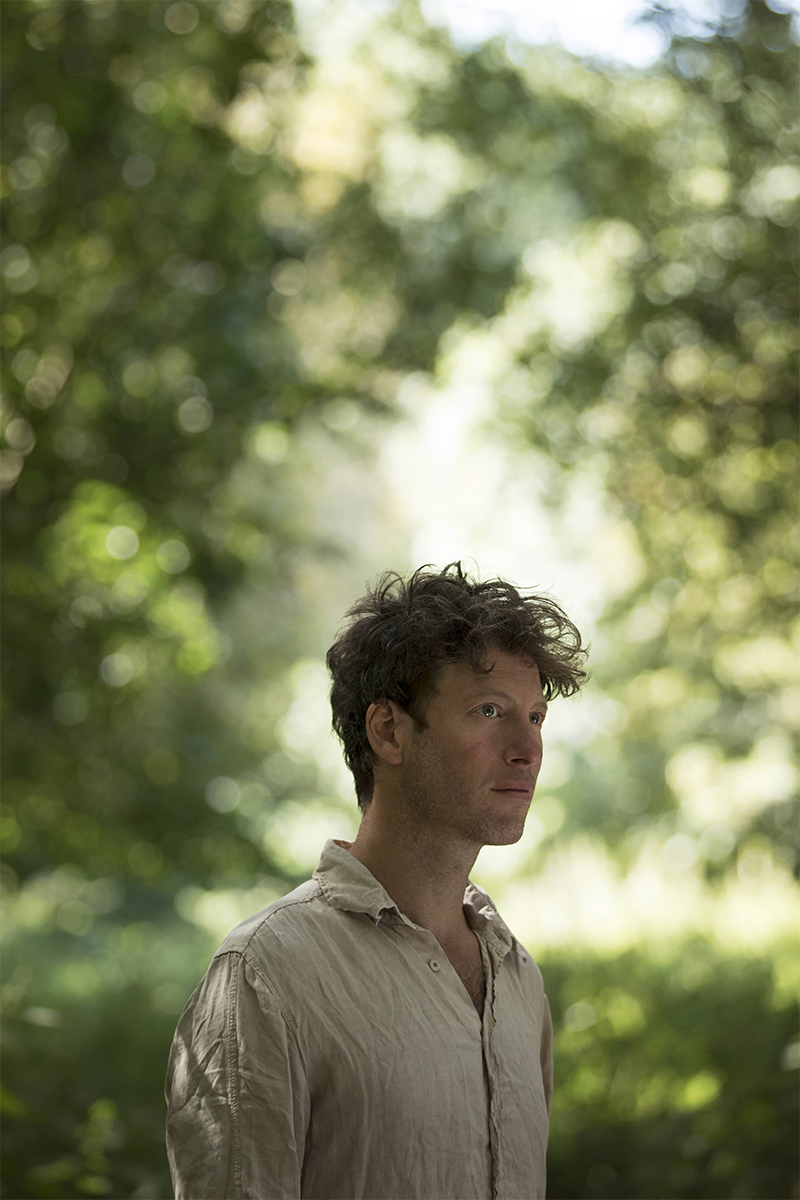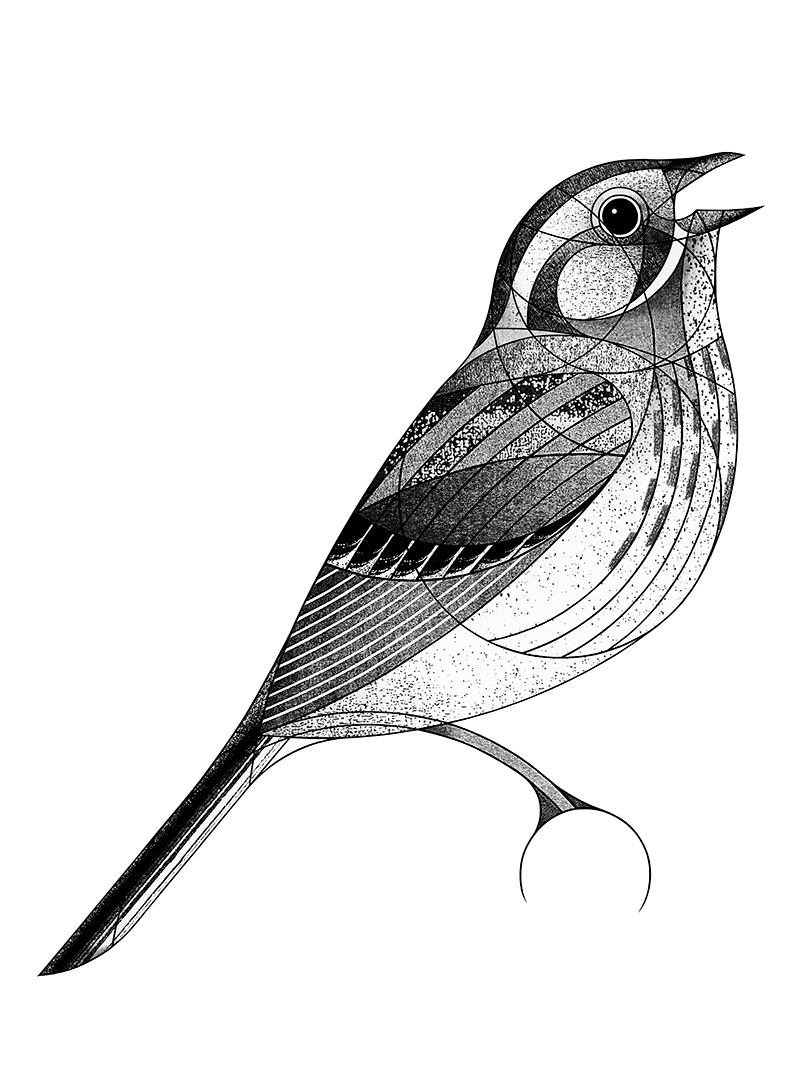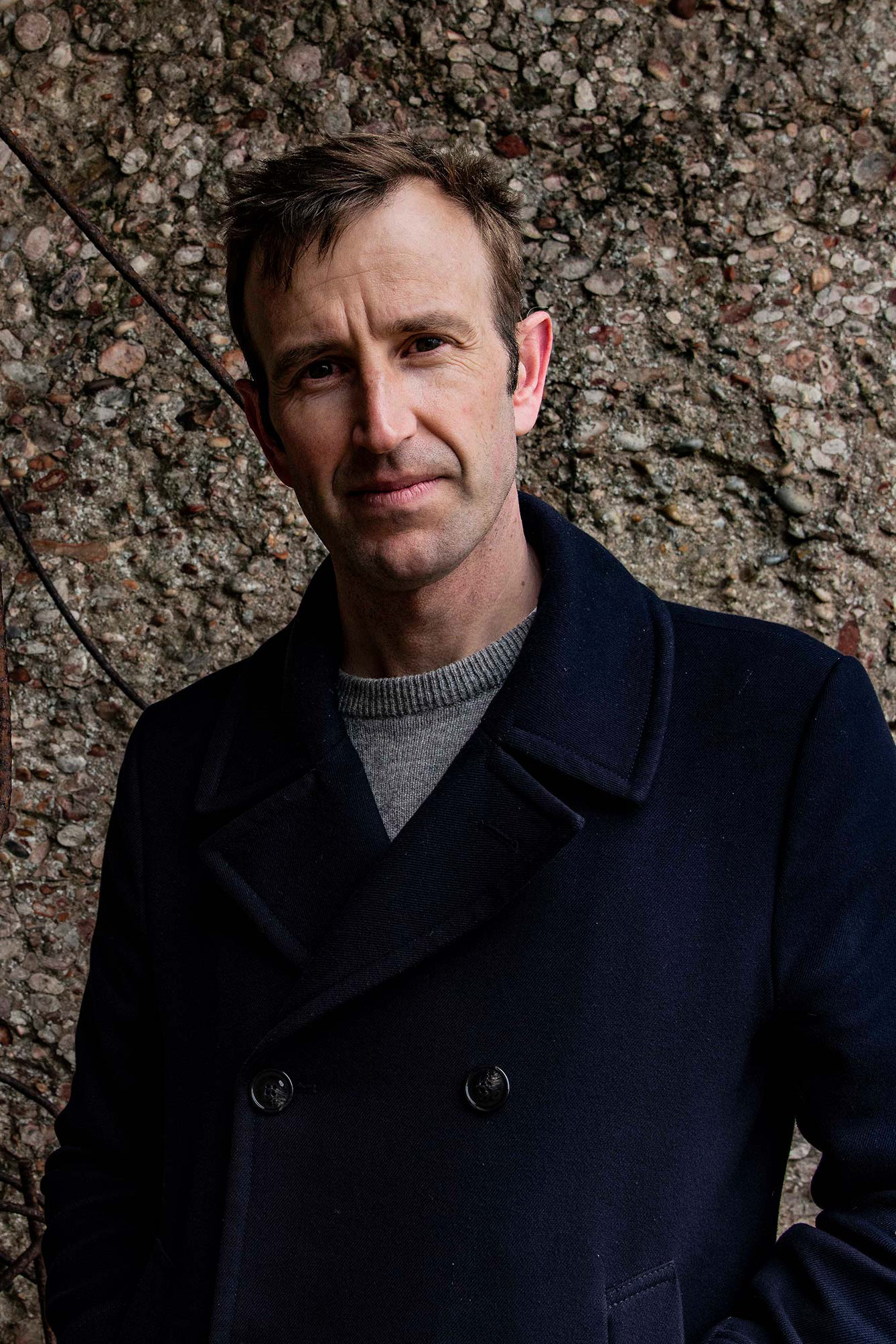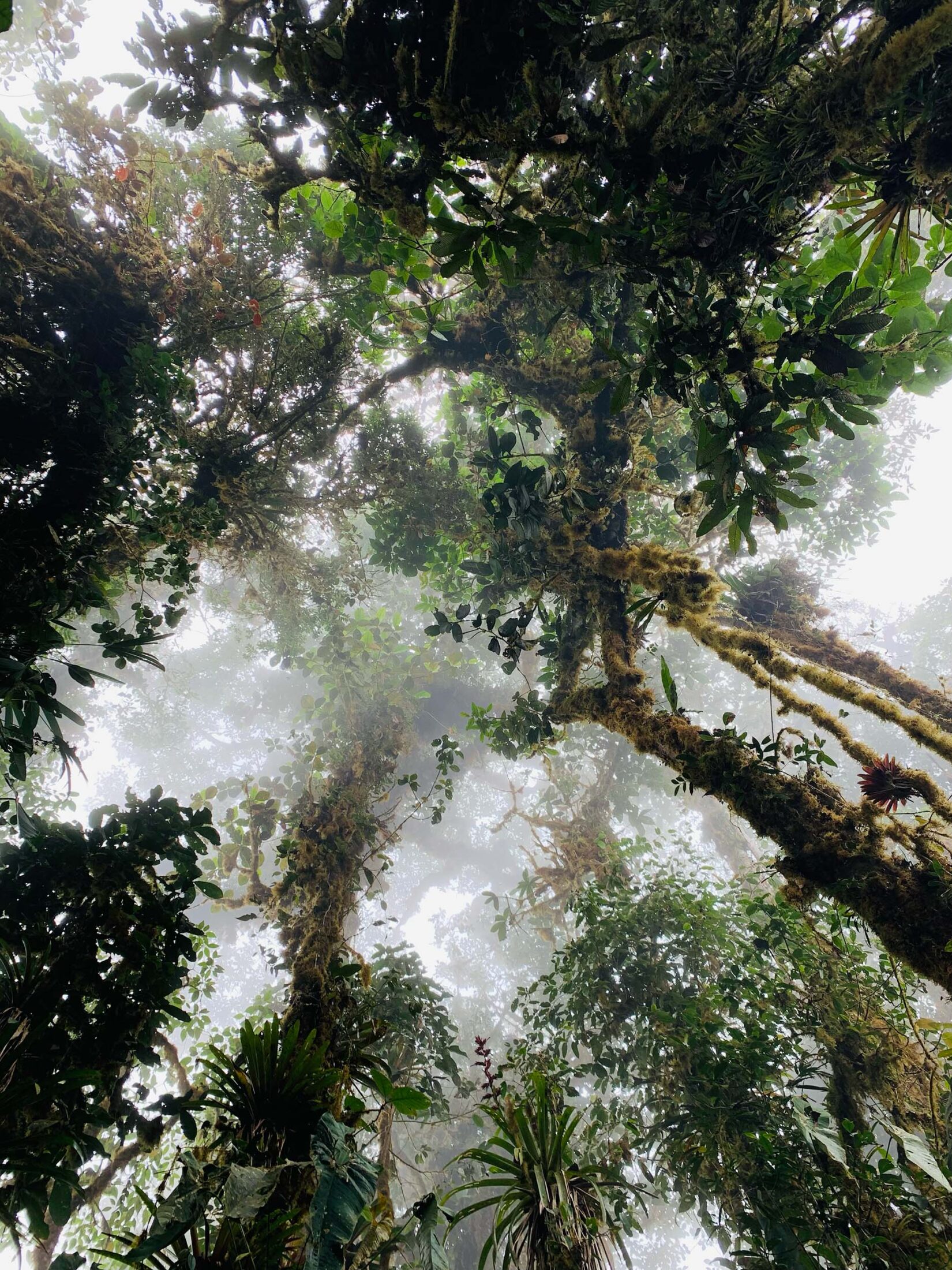
Los Cedros cloud forest
Photo by Robert Macfarlane
Song of the Cedars
Robert Macfarlane is the author of books on nature, place, and people, including Underland: A Deep Time Journey; The Lost Words (with Jackie Morris); The Old Ways; The Wild Places; Mountains of the Mind; Landmarks; and most recently, Is a River Alive? His work has been widely adapted for film, television, music, dance, and stage, and translated into many languages. Robert won the 2017 E.M. Forster Award for Literature from the American Academy of Arts and Letters, and his writing has appeared in The New Yorker, Granta, and The Guardian. He is a core member of the MOTH (More Than Human) Life Collective and wrote the lyrics for “Song of the Cedars.” He lives in Cambridge, England, where he is a Fellow of the University of Cambridge.
Giuliana Furci is foundress and CEO of the Fungi Foundation. She is a Harvard University Associate, Dame of the Order of the Star of Italy, a National Geographic Explorer, Co-Chair of the IUCN Fungal Conservation Committee, a core member of the MOTH (More Than Human) Life Collective, and author of a series of field guides to Chilean fungi. The first female mycologist of non-lichenized mushrooms in Chile, her work has led to the inclusion of fungi in Chilean environmental legislation and made it possible to assess the conservation status of over eighty species of fungi.
César Rodríguez-Garavito is an Earth rights scholar, field lawyer, and the founding director of the More-Than-Human Rights (MOTH) Project at NYU School of Law. His work focuses on the intersection of law, ecology, science, and the Indigenous and human rights movements. He is Director of the Earth Rights Research & Action (TERRA) Clinic and Chair of the Center for Human Rights and Global Justice at NYU. César has been a member of the Science Panel for the Amazon, an expert witness of the Inter-American Court of Human Rights, an Adjunct Judge of the Constitutional Court of Colombia, and a lead litigator in climate change, rights of nature, socioeconomic rights, and Indigenous rights cases. He is the editor of More Than Human Rights: An Ecology of Law, Thought and Narrative for Earthly Flourishing.
Cosmo Sheldrake is a UK-based multi-instrumentalist musician, composer, and producer. His albums include The Much Much How How and I, inviting wildness back into the world; Wake Up Calls, a series of pieces composed entirely from recordings of endangered birds; Wild Wet World, an homage to the ocean; and most recently, Eye to the Ear. In 2019 Cosmo collaborated with Bernie Krause at The Great Animal Orchestra exhibition at Foundation Cartier in Paris, and in 2022 he co-produced and narrated a radio show exploring making music with birds for BBC Radio 3’s Between the Ears. He has toured internationally, composed music for film and theater, and in 2015 he ran a community choir in Brighton. Cosmo releases music through his own label Tardigrade Records.
Bringing in the voice of the forest, four members of the MOTH (More Than Human) Life Collective share the story of co-composing a song with the Los Cedros cloud forest in Ecuador and explore how its authorship might be legally recognized.
Transcript
Robert MacfarlaneWow. Well, let me begin by locating that astonishing soundscape in space and time. So it was recorded in very late October 2022 in a tiny clearing in the heart of dense cloud forest near the apex of a mountain in northwest Ecuador on the Pacific side of the Andean Ridge, in what is quantitatively one of the most biodiverse places on Earth, where life grows on life, grows on life, grows on life, and orchids and bromeliads and other epiphytes flourish on the moss of the trees that towered over us. “Us” because we were all there: me, Robert Macfarlane; Giuliana Furci, mycologist, biologist; César Rodríguez-Garavito, lawyer, activist, academic, scholar; and Cosmo Sheldrake, musician, field recordist—and all of us friends, and made friends by that forest. We traveled there together. We traveled by mule, by vehicle, on foot, eventually up to what we came to call “high camp.” And it was there that Cosmos’s microphones listened to the forest, and they heard the extraordinary screeching strings of the cicadas, and the paso doble of the toucan barbets, and all of the other extraordinary voices and instruments of that place at that time. And below it all, the undersong of river and leaf. We were deep in the green when that was recorded. I’ll begin with you, Giuliana. What do you remember in your skin, in the drums of your ears, in the fire of your memory, about that place at that time?
Giuliana FurciWell, I remember a very exhausting walk up the mountain with a clear mission of finding the high camp and the expectation of space to remain, to be, to rest, to make home, and to remain. I remember being constantly surrounded by horseflies and constantly battling the wish to drink all the water I was carrying. And I remember feeling a big sense of grief all the way up to that expected place. I had just lost my father, and I was very, very sad. And I remember also being very, very trusting in Martin, our guide, and feeling safe. And there wasn’t very much shelter from the rain and the damp, and we were in a cloud forest, so the prospects weren’t 100% great at that time in terms of staying dry. There was a feeling of reaching a place, there was a feeling of reaching a destination, and the feeling of accomplishment in that.
RMThe clearing had something of the space of a theater to it. I remember the tiny stage. We didn’t know what would happen there, but the space was held for all kinds of life and thriving and possibility. César, what do you remember?
César Rodríguez-GaravitoI remember being exhausted but very, very happy, elated. I felt so energized about the life all around us. And because I grew up in Colombia, not far from that place, the first thought was, well, this is what it must have been like. This is what those mountains that I grew up in would’ve looked like centuries ago. And that felt to me very inspiring, re-energizing. And also I was wearing my lawyer hat, but also my sociologist hat, and I couldn’t help realizing that the four of us had spent only a few days together, and yet we felt like friends. I felt this closeness to all of you that I would’ve never felt under other circumstances, but it was all because we were being lifted up by the forest. And the final thing that I remember is that we felt so comfortable that I think it was the next day or that night that Cosmo had the audacity to record night sounds and record me mildly, very mildly, snoring, which is the first time that anyone tells me that I snore. But there’s proof.
RMI didn’t think we’d get on to your snoring quite as quickly as that, though it was definitely on my list. Yeah, the human sousaphone. So I’ll explain shortly why we were there in this high and distant place very, very far from any of our homes, though it had come to feel like a strange kind of home very quickly as you said, César. But Cos, you listen with your eyes and you see with your ears. What do you remember from there?
Cosmo SheldrakeWow. I mean the sense of just abundance and the pregnant becoming—constant state of just being and becoming. I haven’t spent a huge amount of time in tropical ecosystems myself. So for me, it was almost overwhelming, that first encounter with that just sheer polyphony like we talked about earlier. The sound world is so rich. And also, one thing that really struck me was, when we first arrived, Jose DeCoux, who was the current kind of caretaker of Los Cedros, he came out with this line about how even in the last ice age it continued to rain up there, that it was this, you know, it was never frozen. And it had this real powerful sense of this kind of island pocket of life that had stretched all the way back. And you could really kind of feel that. And healthy soundscapes are characterized by the space that everyone leaves for each other and the fact that nobody’s drowning each other out. And it was really present in this place.
RMIt’s a beautiful observation that in a healthy and long-lived soundscape, there is a spatial generosity, we could say: that each sound makes room for the other, or each voice is allowed to sing its part in the polyphony. I want to come back to that because, yes, according to the dry refugia hypothesis, that area of cloud forest may well have thrived undisturbed through the repeated ice ages of the Pleistocene. So we may be listening to a kind of million-plus-year-old soundscape, which will of course have undergone its evolutions and its changes, but they will have been continuous without any great rupture.
You mentioned Los Cedros, and it’s the name I didn’t give to the cloud forest, because I didn’t want to name it in human terms really. But that is the name that it has been given: Los Cedros, the Cedar Forest. And we were there for a number of reasons. We were there partly because that forest had recently, under a year previously, been saved by an extraordinary judgment handed down by the Ecuadorian Constitutional Court, which drew on Ecuador’s constitutional articles recognizing the rights of nature. And they had been used subsequently in November 2021 really to save that forest from devastation by mining, by gold mining. And the devastation was imminent. The threat was absolutely real. So a forest that survived millions of years of ice ages might not have survived the depredations of a multinational mining company in collaboration with the Ecuadorian state mining company.
So we were there partly to lend our respective supports to the protection of the forest, to investigate how the rights of nature ruling had been implemented, the principles upon which it had been made. We were there to make field recordings. And it turned out that there was another reason why we were there, though none of us really knew it before it happened to us. And that’s, I guess, the main reason why we’ve gathered today, to reimagine and revisit that time. And it was to do with the writing of a song, a song that has since entered into the legal arena in, we hope, very consequential ways that we’ll come to discover. But we thought we would just evoke how that song came into being in that place and time, and absolutely, to us, incontrovertibly, with the forest, the cloud forest, and all of its inhabitants—its rivers, its fungi, its birds, its creatures, its mist, its histories, its possible futures—as our co-author, as the co-creator of that song.
And I remember the moment very clearly: I was sitting fairly exhausted in our little clearing, and I took out one of my little notebooks, which I carry around with me or fit into any pocket, and [they] get beaten up and blurred by water and messed up by sweat and foxed. And I love them for it. And they carry memories in ways that the mind cannot, and certainly that phones and photographs cannot. And I pulled it out, and I’d sort of known I wanted to noodle at some lyrics while I was there, but they began to come very fast, to fall from the end of the pen. Very simple lyrics, really. We were around the campfire in the clearing. And these were the words which came to me first:
Trees, speak in your leaves, please
And streams, tell me your dreams
Trees, speak in your leaves, please
And streams tell me your dreams
And at the heart of that opening couplet, as it were, were two things I now see. One is the sense of a sentient, speaking, communicating forest that is speaking to us and with us, that is infiltrating our minds as well as our bodies. And the second is a sense of kind of courtesy and beseeching: please, please do this. And then the second couplet came:
Birds, sing me your rhymes, please
And stones, teach me your times
Again, a sense of a more-than-human world that is profoundly tutelary, educative, helping us think about things that we would be unable to conceive of or imagine without the co-participation of that forest at that place at that time.
Anyway, I noodled these couplets, or rather the forest noodled them with me, and then I took them to Cosmo. And Cos maybe you could pick up this story here.
CSWell, fortunately I had a phone and an app on my phone that allowed me to record on top of, you know, record one part and then stack another part on top. And I’d never used it before, so I was sort of figuring it out as we went but was essentially able to come up with a little melody and then slowly, but surely, start to stack harmonies and just record the verses and explore different melodic ideas really. But what was quite lovely was that just by virtue of recording on my phone with a tiny headphone, I managed to capture all the sounds around us as well. So it was really kind of baked in right from the beginning—the sound we were kind of within. But yeah, like you said with the lyrics, they started just falling out, and it felt that way with the melody too. It just happened remarkably quickly, and that little loop [hums a melody] kind of came quite fast. And from then it was just building, building, building. And then as the words came together and the song came together, essentially by the time we left, it was done. I mean, I then took it back home and wove some of the field recordings that I’d made over the time we were there and rerecorded the vocals and added one or two elements, but functionally, the piece was written beginning to end while we were all up there in the high camp.
RMWell, maybe, let’s listen to it.
[Song of the Cedars recording plays]
Trees, speak in your leaves, please
And streams, tell me your dreams
(Fluye río)
Trees, speak in your leaves, please
And streams, tell me your dreams
(Baja río)
Trees, speak in your leaves, please
And streams, tell me your dreams
(Corre río)
Trees, speak in your leaves, please
And streams, tell me your dreams
(Fluye río)
Birds, sing me your rhymes, please
And stones, teach me your times
(Baja río)
Birds, sing me your rhymes, please
And stones, teach me your times
(Corre río)
Birds, sing me your rhymes, please
And stones, teach me your times
(Fluye río)
Birds, sing me your rhymes, please
And stones, teach me your times
(Baja río)
Earth, cover my limbs now
And mould, thrive on my skin
(Corre río)
Earth, cover my limbs now
And mould, thrive on my skin
(Fluye río)
Earth, cover my limbs now
And mould, thrive on my skin
(Baja río)
Earth, cover my limbs now
And mould, thrive on my skin
Thrive on my skin
Thrive on my skin
(Clouds) Clouds, deepen my sight, please
(Corre río)
(Storms) Storms, lend me your light
(Fluye río)
(Clouds) Clouds, deepen my sight, please
(Baja río)
(Storms) Storms, lend me your light
(Corre río)
(Earth) Earth, cover my limbs now
(Fluye río)
(Mould) Mould, thrive on my skin
(Baja río)
(Earth) Earth, cover my limbs now
(Corre río)
(Mould) Mould, thrive on my skin
(Fluye río)
(Baja río)
(Corre río)
RMWell, who could say that that song was not written by and sung by the forest as well as its human makers? César, I want to come to you because now we turn, really, to the afterlives of this song and the ways it’s moved into law, really. And I’ve never asked you this question, but at what point did you think we can use this, we can do something with this in law that might be new, that might even change things.
CSI had joined the expedition as part of the More Than Human Rights (MOTH) Collective that we all are part of, that tries to bring the idea of the rights of nature from the periphery of the legal field to the center, to recognize that human rights are embedded in the more-than-human world. And that’s why we speak of more-than-human rights. And then the question and the challenge for that vibrant movement of rights of nature is how to make that real, how to turn the aspiration of acknowledging nature, animals, fungi, plants, as subjects—how to turn that into a reality that makes a difference on the ground. And one of the ways to do that is to extract the logical and the legal consequences from the declarations of parliaments and courts that protect the rights of ecosystems or species or even individual non-human beings. And as we were talking about how do we work together going forward, it occurred to me that one way to use the work that we’re doing together, and potentially this song, would be to go back to the same court system that had acknowledged Los Cedros as a subject of rights and ask that judicial branch of the Ecuadorian state to acknowledge the forest as a co-author, as a collaborator, in this musical creation. We had to work for a couple of years, actually, with colleagues in Ecuador who did all the legal work with the MOTH Collective on exactly how to turn that into a legal argument.
RMIn a way we can attribute that idea as well as the song itself, therefore, to the co-presence of the forest. Cosmo, I wonder if you could take us into the weeds a little bit of how music that makes use of the natural world, particularly including samples from field recording, has historically acknowledged that use, and then perhaps how things are changing a little bit. What’s your involvement with the history of sampling and use of natural soundscapes?
CSWell, for me it’s a fascinating area, and I suppose it raises immediate moral conundrums if you’re gonna be in collaboration with creatures and ecosystems. So I’ve encountered this many times through just the fact that I incorporate field recordings of non-human elements. And, for example, when I was making an album called Wake Up Calls, which is all composed from endangered British birds’ song, just thinking it through, who wrote what, really, it comes back to the basics of music law. Like you would never hire a musician to come and sing all over a record but then not credit them in any which way, shape, or form, or not distribute some form of royalties back to them in some form, shape, or way. And so when making this music featuring birdsong—not just in little chunks, but long passages of skylark and long passages of nightingale, and really like maintaining the integrity of the birdsong—it would obviously feel thoroughly inappropriate to then release that without thinking that through, and how to at least acknowledge and share some of the sense of who wrote what, really. So I think the idea had started to dawn on me that maybe finding places that had already been given rights in some ways, and then trying to push those a bit further, might be a nice way into expanding this beyond a kind of legal fiction; truly pushing the boundaries and changing the legal frameworks—to truly acknowledge the authorship and creativity of non-human life, essentially.
RMJust building on what Cosmo has said, then, to identify the process that we’ve engaged in and what we think is new here: So, a legal petition has been filed, in effect, in the intellectual property office of the Ecuadorian government. And that petition asks that office to recognize the moral authorship of the forest as a co-creator with the four of us of this particular song, which has been released. There have been attempts in other jurisdictions to recognize non-human, i.e., creaturely entities, as moral authors of creative works. None of them has been successful. There certainly has not been a legally robust attempt to recognize an ecosystem, in this case a cloud forest and all it contains, as a moral author. But as we have been saying in many ways to all of us here, it is absolutely self-evident that the forest morally authored the song with us.
And the second thing we wished to do was to separate out economic and pecuniary rights and income from, what is called as a term of art within copyright law, “moral authorship.” So this is what we’ve attempted. We are still awaiting a response, I believe, from the patent office, from the intellectual property office. Our hope is slightly that they reject our suit on the grounds that a more-than-human creator cannot be recognized even within the Ecuadorian system, which already recognizes the rights of nature. And then we intend to escalate it up the court system with the support of, of course, Ecuadorian lawyers and colleagues and really to see where this gets to in the court system. So that is the legal novelty.
But Giuliana, turning to you now, when you first met this idea, when we first began to discuss it as a group, what did you think of it and, and how do you feel that you have helped shape it, which you absolutely have.
GFFor a very long time, I’ve dedicated my thoughts to ensure different species of fungi the right to be able to live and thrive. Fungi are very specific to their symbiance. They live together with other organisms in very close and essential and specific relationships. And so what you find [is that] the species and the fungi that you encounter in one ecosystem are drastically different to those that you find and encounter in other ecosystems, and so that specificity and that really entangled relationship between a fungal species and a plant or an animal were food for thought. And there are so many ways to be a fungus, and each one of those ways of being a fungus presents an opportunity to showcase and highlight the life of the symbiont they are living with. So the fungus that grows with a cedar tree doesn’t grow with a birch tree. And the fungus that grows with a puma doesn’t grow with a monkey.
So, in essence, when you look at different types of fungi and ensuring their life and their right to thrive, you’re completely bound to ensuring the right to live and thrive of the species that they live with. All fungi are what we call “umbrella species,” a species that are an opportunity, when given rights and when given protection, to protect many, many, many other species. And traditionally it’s thought that only tigers and elephants were these umbrella species, right? The big charismatic megafauna. But fungi, in essence, hold in my view a bigger opportunity than some of those wildcats to protect entire ecosystems, just by giving them the right to thrive and to live.
RMWhat an amazing thing to hear, to listen to you unfold. And it struck me in the first half of what you were saying that you were, of course, describing an analog or metaphor for the symbiotic process of creativity that was underway in the forest. It was happening within its substrate, as it were, it was contained by it and mutual with it.
César, can I come back to you, please? And could you just set this question of copyright and moral authorship and the more-than-human world in a slightly bigger legal context for us? I remember that when we first began discussing this, you brought us this wonderful phrase, “copygreen”: a deliberate deviation, of course, from “copyright,” and a deviation subsequently from “copyleft,” an alternative sort of open-source movement. So could you tell us about copygreen more broadly as an idea in your thinking and then within the bigger legal context?
CRGYes, copyleft has been around for a number of years now as a system of intellectual property that facilitates circulation of creations of all kinds—books, pieces of art—and that has made a big dent for the better in intellectual property law. When we first began to discuss the possibility of pursuing this legal action, I came up with the term “copygreen” as a way to move us in the direction of acknowledging the authorship, the co-authorship, of the more-than-human world. We wanted Los Cedros, the forest, to be a co-owner of the song and, of course, to potentially get economic benefit from the circulation of the song. And because we wanted to keep the initiative focused on co-creation, we stayed with precisely, as you nicely described it, Rob, with the focus on what lawyers in IP (intellectual property) circles call “moral authorship,” as opposed to “economic ownership.”
So our petition explicitly decouples “moral authorship,” which is what we’re pursuing, from “economic benefits,” which is what we are not pursuing. And that speaks more broadly to me—and I think to all of us, and certainly in the new work of the MOTH project—to a broader idea, to a bigger idea, of how to give back to nature. And this is something that’s coming up in a host of exciting initiatives. One that we’re pursuing with The Biomimicry Institute seeks to find legal ways or ways for the law to pay back to species, for example, that have inspired industrial designs: the Galapagos shark that inspired a product that imitates the skin; paying back potentially the lizard whose gut microbiome has been used to produce pharmaceutical products, and that is now under extinction. So what’s more interesting to me, more than the answers, is the set of questions that becomes possible: one, that moral authorship and that agency of the more-than-human world becomes visible and is acknowledged through initiatives like ours.
RMThanks, César. And it struck me listening to you that when you mentioned the phrase “human exceptionalism”—so you can tell that the rights of nature movement is getting somewhere when it rattles people like Wesley Smith, who directs the Center on Human Exceptionalism and who has identified the rights of nature movement, I think last year, as “a primary threat to human thriving or prosperity, a challenge to our self-concept as a species.” To the first of those clauses, I say: No. It is a generous, wonderful, and sustainable extension to human thriving. To the second of those, challenging our self-concept as a species, I say: Bring it on. How wonderful. We need this now more than ever. And indeed in the US, we are seeing some pretty heavy pushback against attempts at local and regional levels to propose a certain process, rights of nature movement. So it feels a very ancient and a very urgent idea right now.
So Cosmo, it’s easy to say the forest was our co-author. It’s easy to say, well yes, the skylark was a soloist on that track. And those things make absolute sense to me. But is there a qualitative difference for you when you know, when you feel, that you are making with the natural world? And are there times when you feel you are just working with human tools and with human materials? And then are there times when actually you feel that collaboration and that co-authorship intensely and truly?
CSAbsolutely. I mean, sometimes, yeah, I can impose my will on some of the samples and the sounds more than on others. But almost all the time when I start making a piece of music, I’ll often start with a field recording and then allow that to set the tempo, or I’ll often do a kind of aleatoric exercise, where I’ll just scissor things up almost at chance and then rearrange them and try and find little rhythms or beats that present themselves or melodies that already exist, and I’ll often take that as a starting place. And I’ll do my absolute utmost to maintain the integrity of the source material, whatever that be. The one thing I might do most of all is slow things down and speed them up, just because I often use samplers, and also birdsong, obviously—
There’s this wonderful artist called Marcus Coates who revealed the sort of time difference between human and birds’ perception. He did this project called Dawn Chorus, where he got humans to learn specific birdsongs, and then he slowed the birdsong down sixteen times, got the human to learn it sixteen-times slow, which is generally like, woo woo, woo, woo, woo. You know, that kind of human pitch. And then he’ll film them doing it, and then speed them all back up sixteen times. And when you look at the person singing this birdsong—and in this case, almost perfect skylark or thrush or whatever it be—they begin to look like a bird too: their chest, their head movements.
And for me, it was this incredible revelation of just this closing of this temporal gap that sometimes is one of the things that others us from beings, you know, keeps distance. And so often for me slowing birdsong down and working with it on a more human timescale, allows me to close that gap between what would otherwise be somewhat out of reach from a kind of human comprehension. And I find myself getting into the rhythm and textures of the birdsong in a whole new way. And it shed so much new light on the way that I listen to birdsong now. Not only has it completely changed the way that I listen to everything—music and the sonic world around me in general—but I often very intentionally try and take cues or themes or rhythms or melodies or things from both animate and inanimate sound worlds and things around me. And I feel like some of the things I feel most happy about that I’ve made have always had the very strong stimulus from that sort of external input. It’s sort of allowed me to appreciate what’s already given to us on a daily basis.
RMIt’s a beautiful hymn to the collaborative nature of creation, the ineluctably collaborative nature of creation. It also speaks to the opposite, which is, shall we say, the Western grammar of creation, which has long centered, and particularly in postromantic centuries, has centered the singular creator, often a male creator, working in the windless solitude of his ego, unaccompanied, unaided, certainly solo. I think of a line that Wordsworth used of Coleridge: he said his poems were “perfectly unborrowed and his own”—so this idea of creation from absolute ex nihilo within the sealed skull. Of course, this is absolute nonsense: as Wittgenstein tells us, there’s no such thing as a private language. And there are so many other philosophical and practical objections to the notion and, indeed, sociological objections to the notion of the sole creator. But they remain powerful. These anthropocentric singularizing presumptions, inheritances, are the foundation of highly anthropocentric, highly singularizing copyright law. And these are some of the things that we are pushing against. And they’re heavy blocks. It takes a lot of effort to shift them.
Thinking about what César was saying about law. And I always find it very inspiring, César, when you remind us that law is a storied thing and, therefore, that it can be re-storied. And, Giuliana, you’re this extraordinary, to me, metaphysician of mycology. You speak in a very—naturally, I think—almost theological way that I find very beautiful and opening of thought, to me, about the fungi to whom you’ve dedicated your life from a very young age in a very utterly generous way. But you also work really hard within the traps and the rigors of regulation and law. And I wonder if you could just say a little to us about how fungi, how their role as authors, as makers, as creators—how you have fought to open law and regulation to recognize that agency.
GFWithout sounding completely dissonant with most listeners, I think there’s something that I’ve over time heard, or feel that I’ve heard, or felt from the fungi themselves of what I could do as a human for them within existing frameworks; and I think that on one hand. And the other big driving force is a sense of justice. Now when you look at fungi in particular, and you look at existing frameworks—legal, taxonomical, scientific—we’ve been very unjust to them. We’ve used fungi to shape our existence, to shape humanity. We cultivate them. We depend on them, we bioengineer them, but we don’t even say their name within a legal framework. And so a sense of justice was the driving force in my case; and listening to fungi, with their help, I felt that there was something that I could do without having to build whole new frameworks, but rather face this sense of injustice by striving for fungi to be acknowledged within existing frameworks. It’s a very simple strategy and very essential. It gets complex when you get into those political scenarios. But the strategy, the idea, is very simple, and it’s very evident when you’re in communion with them.
RMLet them speak and be spoken of. I want to ask a really hard question. It’s the question of will, I suppose, or of co-option. We’ve talked a lot about sampling and taking and using and exploiting. The forest didn’t in any way assent to our sampling of it, our recording of it; it didn’t agree to be a co-author within human legal frameworks and structures. Are we just co-opting and using the forest’s polyphony, albeit in ways that we think are for the good of the forest and forests like it?
GFWell, I think that goes precisely to what I was just mentioning, Rob. I mean, the fungi haven’t been able to tell everybody that they want to be considered on an equal footing as plants and animals. And I mentioned, in my case, it’s a spiritual connection where I believe that there’s purpose, and I’m convinced, and there’s a space for that in the world, and there are other people that believe in it, and it leaves just that individual connection and becomes a collective mission. So I think it is a valid question for all of us who speak in human settings about justice or rights or consideration of non-human beings.
RMCésar? Cosmo?
CSSo I’ve thought about this long and hard for a long time, and I haven’t got to any sort of definitive or clear way of maybe articulating some of the moral quandaries. I think it’s just about keeping those questions alive all the time, really. Like, as we described so many times, every act of creation is so enmeshed and embound in this kind of—again, like, we’ve talked about this idea of the symbiont and all of us being kind of ecosystems rather than individuals. So a lot of the time now, my approach has gone from this kind of—I suppose it’s all extraction in some way—but rather than trying to isolate something from its context and put it somewhere completely different—which is maybe more like the British Museum or these kind of more imperial, colonial kind of enterprises, of just gathering things, stripping them from their context, arranging them in these kind of glass display cabinets so everyone can appreciate the weirdness of the world. So I suppose it’s all about how you go about things.
For me, my intention more and more has been to try and maintain things within their context, in their ecosystem, try and really sensitively engage with them in a way that, again, just comes back to the fact that I truly believe all of these things are collaborative exercises. I think that the biophony, the natural soundscapes, needs to include human music too. And in rare occasions it truly does. But—and this is just a personal feeling, and I’m sure millions of people will tell me I’m wrong—but when you really hear birds just singing in the morning, and it’s just that dawn chorus eruption of joy and stuff, my sense is it’s freely given, and it’s in the air, and the air is the commons. Obviously, the second I then record that and start selling it to someone that changes. But if there’s a way of, yeah— For me it’s just this joyous participation in the world of which we are all a part.
CRGI agree with Cosmo, just building on what he just said. It all depends on whether, to me, whether the giving from nature is reciprocated, whether we give back. And as a researcher and as a lawyer, I’m committed to giving back. And I think that we have pursued this effort to publish the song, to file the legal petition, as a way to give back to the forest as a means towards the protection of the forest from mining, from ongoing threats to the ecosystems around it. And the proof is in the pudding. Is the forest doing better now? Are we giving back in the form of the report that the MOTH Collective published on the implementation of the 2021 Constitutional Court ruling? So giving back, going back, keeping in touch, reciprocating is to me the way that we as human beings, but also as lawyers and as researchers and activists, can ensure that we get closer to an ethic of reciprocity. And I love that the origin of the word “reciprocity” comes from the Latin word that means “back and forth.” So there is a back-and-forth, a dance. The birds give, we give back, and we engage in a continuous dance of reciprocity. And if the forest continues to thrive, if the protectors of the forest benefit from the efforts to co-create music with the forest, then that, for me, is quite inspiring and is comforting, because it gives us a clear sign that the forest would be or is consenting to these forms of co-creation.
RMAmazing. Thank you.
Well, we’ve come to the end of the conversation and so I thought it would be appropriate for us to leave with the voices of the forest as the last voices that you’ll hear. So I think we’ll end on a recording which begins in the soil, very subtle sounds, you’ll have to lean your ears in to hear them, and then expands outwards back into the many voices of the forest. Thank you for listening.

